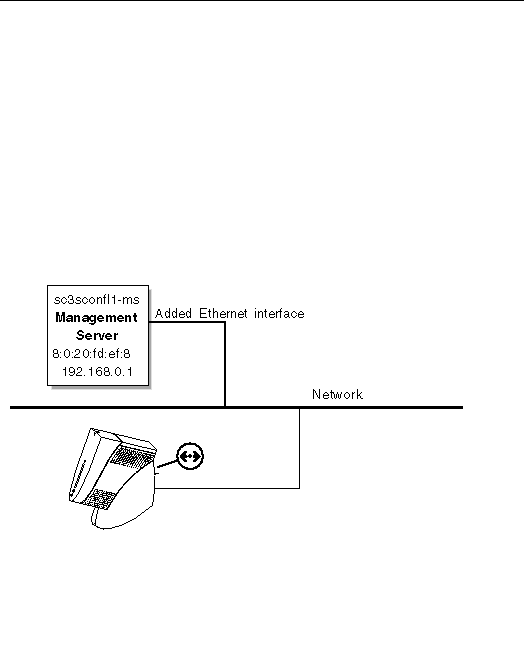| A P P E N D I X F |
|
Configuring the Sun Ray Server Software on the Management Server |
The Sun Ray server software is preinstalled on the Cluster Platform management server. To use this feature you must:
server software is preinstalled on the Cluster Platform management server. To use this feature you must:
This appendix provides the settings and cable connections required to set up and configure the Sun Ray server software with an optional Sun Ray appliance.
server software with an optional Sun Ray appliance.
FIGURE F-1 shows the management server with an additional Ethernet interface used for the interconnect.

1. Access the configuration file from the management server.
# cd /opt/SUNWut/sbin # ./utconfig |
2. Type y to run the configuration script to install the Sun Ray server software:
3. Enter the administrator password to access the Sun Ray server:
Enter UT admin password: abc123 Re-enter UT admin password: abc123 |
4. Type y to configure the Sun Ray server:
Configure Sun Ray Admin Server 1.0 ([y]/n)? y |
5. Type the port number to access the Sun Ray server.
Enter Sun Ray Admin Server port number [1660]: 1660 |
6. Type the user name to access the CGI server:
Enter CGI username [utwww]: utwww |
7. To enable remote administration for the Sun Ray server, type y. Otherwise,
type n:
Enable remote server administration? (y/[n])? y |
8. Type n to disable SSL (Secure Socket Layer) connectivity.
Selecting remote administration without SSL poses a potential security risk and is not advised. Enable Secure Socket Layer (SSL) connection ? ([y]/n)? n |
9. Type y to configure controlled access mode:
Configure Controlled Access Mode? (y/[n])? y |
Enter user prefix [utcu]: utcu |
11. Type the starting range for the user ID:
Enter userID range start [150000]: 150000 |
12. Enter a value for the number of users accessing system administration:
Enter number of users [25]: 25 |
|
Note - Refer to the Sun Ray Server 1.3 Installation Guide, included with your Sun Ray*. |
*Available if you purchased the Sun Ray option.
13. Type y to configure the Sun Ray server for a failover group. Otherwise, type n:
Configure this server for a failover group? (y/[n])? n |
14. Wait for the Sun Ray server configuration to complete. Type y to continue with the configuration:
15. Type the following at the Sun Ray server:
# ./utadm -a Ethernet-interface |
16. Verify the configuration files, services, and network addresses. To accept the configuration files, type y. To change any of the values, type n, and enter information at the prompts.

|
Caution - To select a different IP address, type n, and enter the IP address for your enterprise. |
17. Wait for the setup of the configuration files.
18. Create user accounts on the management server.
|
Note - If you need to log into the management server as root, you must edit the /etc/default/login file and comment out CONSOLE=/dev/console. |
Copyright © 2002, Sun Microsystems, Inc. All rights reserved.